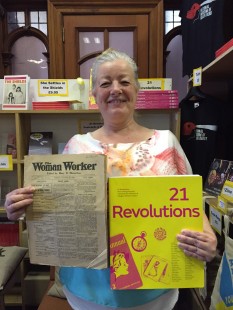
Lassie Wi’ a Yella Coatie by Anne Donovan is a short story in Glasgow Women’s Library’s 21 Revolutions book. The story is narrated by a young man in Glasgow in the early 20th century and tells the story of the girl he was courting who was a factory worker in the dye works and the working conditions and the dangers she was exposed to. Women in the factory were exposed to dangerous levels of lead poisoning. When the women were employed in the factory they knew it came with a health warning but they had to make a living. They had no choice – this was the risk that came with the job.
This was a riveting read and very sad read. It really caught my attention and fired up my curiosity to find out more about these factory women and the conditions they had to work in and how the lead dyes affected their health and the devastating cost they had to pay to survive. It really pulled at my heart thinking about the suffering these women had to go through.
I wanted to know how their health was affected, what were the consequences of them having to work in the factory, what the government was doing to change the working practices to make life better for working women and how much (or how little) has changed in the following 100 years for women here and in developing countries.
Glasgow Women’s Library has a collection of newspapers called The Woman Worker – it is a wealth of information about women’s history. One of the papers, dated Friday 21st August 1908, has an article on Women In Fatal Trades. It talks about how women suffer in dye works. When pulling and manipulating yarn their hair, hands, skin and clothes were turned yellow with deadly dust and this led to horrible health problems and premature death.
The article covered a wide spectrum of factory work. The paper said many of these women were sacrificed. They were maimed and poisoned trying to earn a living in enamelling factories and dry cleaning works and many more industries – all victims of their working environments.
To my horror I found it really hard to understand why these poor women were considered so insignificant and replaceable by another human production line which was a horrible working existence. It seems as though the employer had no conscience and felt no responsibility toward his workforce. If one fell ill they could be replaced and exploited just like each one before.
The government of the time were just as bad as the employers, because they, too, were benefitting from this cruelty. They dragged their heels. Reformers urged change. Denmark and France agreed to stop the use of white phosphorus, but Britain did not.
Well, that’s the early 20th century and our governments are still dragging their heels and in the meantime other poor countries are picking up where our Victorian workforce left off. Workers all over the world are being exposed to pollution from dye works and other industries. There is expulsion of waste into rivers and children and families are exposed to industrial pollution which affects the environment and climate and health of these nations. But do these governments care? Do you care? Or will we just keep buying our cheap disposable fashion? Who cares?
You can read Anne Donovan’s wonderful story in 21 Revolutions, which is available at Glasgow Women’s Library. And, if you want to find out more about The Woman Worker, read Mikaela’s blog post.
By Anne Marie Shields

6 replies on “A Day in The Life of A Victorian Woman Factory Worker”
What a great blog! You found things in this story that I had not thought about and I love the way you get across to the reader what you learnt through reading this piece. You have a real flair for blogging and I hope you can take the time to do more, will be looking out for your voice on the website and many congratualtion on this great debut!
Adele x
Great blog post Anne-Marie. I also love this story, but your comments made me think about it again – how relevant it still is to women in 21st century.
This is very though provoking post Anne-Marie.
I think it’s very important to be highlighting the link between the exploitation of people in the 21st century and the way workers were exploited in the UK a century ago.
Please keep blogging! Gabrielle :)
WOW! What a powerful Blog post.That last paragraph with the question, ‘do you care’ really brings the issue home. Made me think a lot, thanks for such a thoughtful and articulate article.
Absolutely fascinating blog written with a really engaging voice. Challenges the reader to stop and think – brilliant!
What a fabulous blog post! Wonderfully written and researched! Keep up the good work! A x